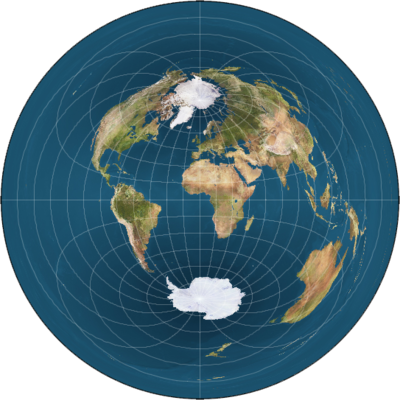61
Flat Earth Theory / Re: Circumnavigation of Earth through poles
« on: August 28, 2017, 10:15:02 PM »How is it possible to circumnavigate the Earth longitudinally? I want to ask the question that if we go from the North Pole to the South Pole, how come we don't just fall off the Earth?That is indeed a problem in the ice wall model, how circumnavigation via the poles could be done. The only possibility I know of is that they crossed past the ice wall and circled around the circumference of the antarctic circle above the ice to make it to the other side. The distance would be longer and there would need to be some exaggeration of the speed of the plane, distance traveled, and the navigation method for this to be true.
Otherwise, there is the bi-polar flat earth map, where they crossed the south pole and came back around:

And then there is my favorite model (the one I adhere to), the Davis relativity model, where aether (space-time), bends around the Earth, where you can traverse the Earth in a straight line as a flat plane, but the aether you are traversing within curves and you circle back. Basic entry here: https://www.theflatearthsociety.org/tiki/tiki-index.php?page=Davis+Model
Quote
Please read this link - it shows that a person actually did this once. I still want to reiterate the question of why the Earth bulges at the equator. By understanding seismic activities, and how the waves travel through the Earth, we can see that the Earth has a horizontal radius that is 26.58 miles longer than the vertical radius. Why? In the 17th century, following the invention of the pendulum clock, French scientists found that clocks sent to French Guiana, on the northern coast of South America, ran slower than their exact counterparts in Paris. Measurements of the acceleration due to gravity at the equator must also take into account the planet's rotation. Any object that is stationary with respect to the surface of the Earth is actually following a circular trajectory, circumnavigating the Earth's axis. Pulling an object into such a circular trajectory requires a force. The acceleration that is required to circumnavigate the Earth's axis along the equator at one revolution per sidereal day is 0.0339 m/s². Providing this acceleration decreases the effective gravitational acceleration. At the equator, the effective gravitational acceleration is 9.7805 m/s2. This means that the true gravitational acceleration at the equator must be 9.8144 m/s2. This difference in acceleration is massive, all because of Newton's Law of Universal Gravitation, which, according to the law, shows that the Earth must be round because all mass is attracted toward's one another.I recommend you look into Mach's principle. Essentially, any frame of reference (FoR) considered as geocentric would involve a 'celestial gravitation' as influencing the local physical characteristics of such a local physical FoR, in such a way so that the term "mass out there influences inertia here" holds true when taking geocentricity as your preferred relative movement.
Here's a great example:
Suppose we took a bucket of water at rest, and stirred the water so that the water rotates relative to the bucket, then, we got the water rotating relative to the stationary bucket. Now, lets suppose we rotated the bucket instead, so the bucket was rotating relative to the stationary water, but if you do this, the water will start to rotate with it, giving the same effects that water rotating relative to the stationary bucket would have. So, we can postulate, that in a local frame of reference, the rotation of the Earth relative to the stationary celestial bodies is indistinguishable from the rotation of the celestial bodies relative to the stationary earth, because of how the celestial bodies would affect the Earth, giving centrifugal force by interaction between these masses.
A good basic read: http://www.commonsensescience.org/pdf/articles/machs_principle_and_the_concept_of_mass_fos_v16n3.pdf

